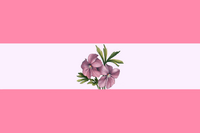Sapphic, sometimes known as women loving women (WLW),[1] or sapphist,[2] refers to a woman or woman-aligned person of any sexual orientation who is attracted to other women and/or women-aligned individuals.[1][3] Another definition is specifically inclusive of non-binary people.[1] It is an umbrella term for many identities, including those who are lesbian, pansexual, bisexual, or queer.[3] It is used to promote solidarity among women and non-binary people of all identities who are attracted to those who are women and woman-aligned. It may also be used as an identity, and may be found particularly useful for individuals who know they are attracted to women but may be uncertain if they are attracted to other genders.[4] It can also be used to describe a relationship between two women.[5][6]
Etymology
Sapphic as an adjective came into during the 16th century in reference to Sappho, poetess of the isle of Lesbos c. 600 BCE. The word was used especially in reference to the characteristic meter of her poetry, and it was not until the 1890s that it gained its meaning of "pertaining to sexual relations between women";[6] the noun "sapphism", meaning "homosexual relations between women", also originated in the 1890s.[7] "Lesbian" and its meanings are similarly derived from Lesbos, the isle associated with Sappho.[8]
Community
History
The term sapphic is derived from the Greek poet Sappho, who lived on the isle of Lesbos. The sexual identity of Sappho has been long debated and continues as such to this day. Some interpret her poems as meaning she had relationship with women. Her new style of poetry was called a "sapphic stanza". Her songs often mentioned various emotions to her susceptibility to women, which later, derived the terms sapphic and lesbian.[9]
Because the term bisexual did not come into popularity until the 1950s, the words "sapphic"[1] and "lesbian" were used to describe a potentially romantic relationship between two women.[1][8] In the mid-20th century, "lesbian" and "sapphic" were often synonyms. In the 21st century, it has become an umbrella term used to describe any romantic relationship between women or non-binary people. The uptick in searches for the term sapphic have increased since 2014.[1]
Flag

The original sapphic flag with a more realistic violet
Two sapphic flags have two pink stripes on the top and bottom, symbolizing love, with a lavender center stripe. The center of the lavender stripe depicts a flower. In one version, a pair of violets in the center symbolizes love between two women;[10] the second version has a single simplified flower instead.
Distinction
The word "sapphic" is often confused for "lesbian" or thought to be the same thing. They historically were equivalent, but because they have accumulated multiple definitions, their meanings are ambiguous without specifying which definitions are used.[1]
For instance, when lesbians are defined as women who are exclusively attracted to women only,[11] it would not include those with multisexual orientations or non-binary identities. When using that definition, sapphic could then be distinguished as an umbrella term by including all sexualities in which women are attracted to other women, by explicitly including non-binary identities, or both. Under those specific definitions, pansexual and non-binary would be mutually exclusive with lesbian, but a pansexual non-binary individual could be sapphic.[1] However, although lesbian is often regarded as an exclusive term, it likewise has definitions inclusive of non-binary[1][11] and/or multisexual lesbians.[1]
Media
Literature
- The Ultimate Sapphic Masterlist of 2020 - All these books have moments in the text where it is shown a character is WLW, however, some characters use a specific label (i.e., lesbian, bi, pan) to identify themselves. Others use the term "sapphic" to describe themselves or their relationship(s).
- Sapphic stanza
- Katie Met Cassidy by Camille Perri
- The Well of Loneliness by Radclyffe Hall
References
- ↑ 1.0 1.1 1.2 1.3 1.4 1.5 1.6 1.7 1.8 1.9 Chandra: "Why 'Sapphic' Is Back In Style" (2021-08-09). Autostraddle. (Archived on August 13, 2021).
- ↑ "Sapphic/Sapphist". alpennia.com.
- ↑ 3.0 3.1 PFLAG: "National Glossary of Terms". pflag.org. (Archived on January 25, 2022).
- ↑ Queer in the World: "What Does Sapphic Mean? + Other Sapphic Information". queerintheworld.com.
- ↑ The Sex and Secrets Column: "5 Reasons Why I Recommend Being in a Sapphic Relationship". medium.com.
- ↑ 6.0 6.1 etymonline: "Etymology, origin and meaning of sapphic". Online Etymology Dictionary.
- ↑ etymonline: "Etymology, origin and meaning of sapphism". Online Etymology Dictionary.
- ↑ 8.0 8.1 etymonline: "Etymology, origin and meaning of lesbian". Online Etymology Dictionary.
- ↑ https://www.newyorker.com/magazine/2015/03/16/girl-interrupted
- ↑ Smith, Erika: "Violets, Bi-Angles, And Double Moons: A Guide To LGBTQ+ Symbols" (2019-06-20). refinery29.com. Refinery29.
- ↑ 11.0 11.1 The Trans Language Primer: "Lesbian". The Trans Language Primer. (Archived on October 22, 2021).
